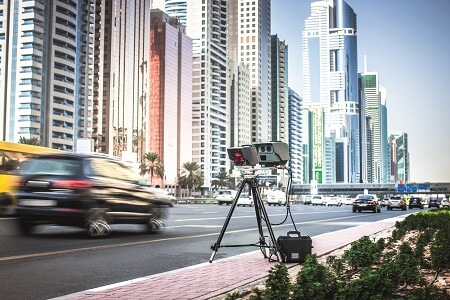Due to widespread adverse implications of car accidents and fatalities, Middle East countries are now waking up to the importance of improving road safety and are making it a high priority in their development agenda.
Urbanization is an inherent part of economic development. As more people move into cities, more cars are also on the streets, increasing the risks of traffic accidents. The incidence of which not only poses a huge consequence on human lives, but also a burden on a country’s health, insurance and legal systems. This inadvertently takes a huge toll on the country’s economy as well, typically costing countries 3 percent of their gross domestic product (or up to 5 percent in low- and middle-income countries) as stated by a report by the World Health Organization (WHO).
Due to these widespread adverse implications, countries are now waking up to the importance of improving road safety and are making it a high priority in their development agenda.
This holds particularly true for the Middle East region. In previous years, this part of the world has been listed as having the second highest road traffic fatality rate in the world after Africa, with reports stating that car accidents are the leading cause of mortality among the younger population. A WHO report classified most of the East Mediterranean countries as having poor traffic data collection and accuracy, and another even ranked the Kingdom of Saudi Arabia 23rd globally in terms of deaths due to road accidents.
UAE Road Traffic Accident Statistics (1st half of 2017)
| 2,133 accidents |
| 3,015 injuries |
| 315 deaths |
| Source: General Directorate of Traffic Coordination, Ministry of Interior |
This poor road safety performance has become a critical issue for local governments. “Speeding, reckless driving, distracted drivers and not using seatbelts continue to be the main concern for most law enforcement authorities in the Middle East. The main consideration is to ensure that the public is using national roads responsibly and that measures are in place to enforce the same,” said Ettiene Van Der Watt, Regional Engineering and Training Manager for Middle East and Africa at
Axis Communications.
Many countries in the region have clearly stepped up their national road safety campaigns, coordinating efforts to set speed limits and raising awareness of safety measures as well as the consequences of not following driving regulations. “Initiatives within the framework of traffic law enforcement focus on traffic safety — in general terms — as well as driver education. The aim is to achieve greater awareness of proper and courteous behavior in road traffic — for example acting correctly at traffic lights. This aspect also includes appropriate consequences of non-compliance with traffic regulations,” said John Yalda, Sales Coordinator for Traffic Technology in the MENA Region for
VITRONIC.
Top 9 Causes of Traffic Accidents, Death and Serious Injuries in the UAE
| Sudden swerving/lane changing |
|
Misjudgment
|
| Not enough distance to the car in front |
| Entering road without checking if clear |
|
Speeding
|
| Lack of attention |
| Jumping red lights |
| No lane discipline |
| Miscellaneous |
| Source: Ministry of Interior, 2015 |
Effective traffic enforcement is key
 Klaus Theml,
Klaus Theml,
Head of ITS Middle East,
Siemens
Nonetheless, awareness and education programs, albeit important, are only part of the whole equation. Basic human nature dictates that people who get the impression that they will be caught and punished are more likely to deter from doing the act in the first place.
Earlier this year, PwC (PricewaterhouseCoopers) Middle East, in partnership with Loughborough University, published a report entitled “A Guide for Policy Makers: on Reducing Road Fatalities” aimed at assisting governments in the Middle East, and the rest of the world, develop strategies to improve road safety. It proposed that countries adopt a mixed approach: using a “3 E’s” strategy: Education, Enforcement and Engineering as well as a “Safe System Approach”: Safer People, Safer Vehicle and Safer Speeds.
In both of these strategies, one essential aspect stands out — the need for effective enforcement. The traditional way to achieve this would be through police visibility, increasing road patrols and establishing a constant presence on the roads to deter would-be offenders. However, this would necessitate a significant increase in manpower and resources, which isn’t ideal in most cases.
 Ettiene Van Der Watt,
Ettiene Van Der Watt,
Regional Engineering and Training Manager,
Middle East and Africa,
Axis Communications
As such, many countries are looking to invest into other means, and this is where technology increasingly becomes an important part of the whole picture. Technology, mostly video-based , is now being widely leveraged to aid law enforcement officials keep the roads safe through either determent of potential traffic violations or catching violators in the moment and automatically issuing tickets and sanctions.
A notable example of this in action can be seen in the United Arab Emirates (UAE). As part of the UAE’s ongoing efforts to become “the safest place in the world,” it has listed lowering road traffic deaths as a key indicator in its Vision 2021 National Agenda. Several measures in Dubai, including an amended federal traffic law that came into effect in July 2017 which reexamined traffic violations and raised penalties, were also implemented to enhance road safety and get UAE closer to its goal of reducing traffic casualties from about 6 per 100,000 people in 2016 to 3 per 100,000 by 2021.
Local news sources reported that Dubai launched a “comprehensive and integrated speed management strategy” in 2014 to improve speed limit compliance. Apart from increasing enforcement patrols, the plan entailed the addition of more devices and technology to aid in monitoring and enforcing sanctions for traffic violations.
 Source: VITRONIC
Source: VITRONIC
It is important to note, however, that finding and implementing road rules and corresponding technology is a complicated process in the Middle East as it encompasses a sprawling region consisting of different countries with varying country-specific practices, traffic laws and requirements. This makes a blanket “one-size-fits-all” solution an impossibility.
“The challenge in the Middle East is that various government entities are specifying enforcement solutions which require a high customization effort. As a global trend, the investment in road safety/enforcement technology requires careful evaluation for the local market requirements,” said Klaus Theml, Head of ITS Middle East at
Siemens. “As an enabler for change in driver behavior, there are several emerging technologies which authorities need to address; a range of problems for law enforcement and traffic efficiency. Many of the scenarios such as junction blocking/don’t block the box provides a road safety plus traffic efficiency impact.”